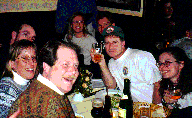Brewtopia Events

Commercial Beers - Blind Tasting Results
Belgian
White Beers
India
Pale Ales
Oktoberfests
Pilseners
Stouts
More beer destinations on our Brewtopia Events webpage...
-
Atlanta, GA
-
Austin, TX
-
Belgium
-
Chicago, IL
-
New Orleans, LA
-
New York, NY
-
Germany: Munich, Bamberg,
Kulmbach, and Berlin
-
Philadelphia, PA
-
Salt Lake City, UT
-
Tampa, FL
-
Chimay Trappist
-
Orval Trappist
-
Rochefort Trappist
-
Westvleteren Trappist
-
Westmalle Trappist

|
|
| After
about two hours of driving through the Belgian countryside, our first stop
on Thursday morning was the St. Bernardus Brewery (Trappistenweg 23 in
Watou.) The brewer gave us a tour of the facility, which is not normally
open for public tours (Owen contacted them well in advance of our trip).
After the tour, we went to the very comfortable and beautifully decorated
tasting room. We tasted two of the St. Bernardus beers - the Watou
Tripel and the Abt 12. Watou Tripel was the first beer tasted: light
in color, high in alcohol, complex, spicy, peppery, fruity, malty.
Abt 12: dark color, fruity, plum flavors, depth, complexity, banana.
As we were leaving, the brewers from St. Bernardus gave each of us a five-beer
sampler pack to take home. Along with the great beer, we enjoyed
friendly conversation with the brewers. They were exceptionally accommodating
and treated us like royalty. The brewery also has a beautiful inn
to the rear where tired beer travelers can stay the night.
Lunch on Thursday was at 't
Hommelhof (Watouplein 17 in Watou-Poperinge.) Hommel is
the Flemish word for hops, so Hommelhof would translate as "hops house."
The restaurant specializes in cooking with beer, and the Watou-Poperinge
area is famous as a region where hops are grown. There were masses
of dried hops hanging over the bar area of the restaurant. After
our lack of sleep on the plane, we all opted for water and coffee with
lunch. (I think that is the only meal other than breakfasts that we didn't
drink beer!) Some of our favorites at t'Hommelhof were: the
great Belgian coffee, fois gras, chicken with beer sauce, "frites" (french
fries, these were present at most meals), warm vegetable plate with lots
of herbs (maybe even some hops), toast with goat cheese over greens with
framboise. |
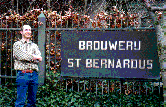
St. Bernardus brewer...
"I feel like Clinton!"

St. Bernardus brewer
& owner
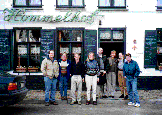
Lunch at Hommelhof
|
| Our
next stop was Van Eecke Brewery (Douvieweg 2 in Watou), which was within
walking distance of t'Hommelhof. The brewer, Bart Verfaille, gave
us a colorful and comprehensive tour of the brewery. At the beginning
of the tour he mentioned St. Bernardus as another brewery in the area,
but explained that we couldn't visit there. We didn't want to be
rude so we just didn't mention that we had toured there first. Van
Eecke uses a special chiller/filter instead of a lauter tun to separate
the wort from the grain. They had an amazing bottle washing machine
the size of a room, which is no longer used. The brewing is done
at the facility we toured in Watou, but all bottling is now done at another
facility in Iepers. At the conclusion of our tour, the brewer gave
us each a hommel-bier cap and a six-beer sampler to take home. We
didn't have the chance to taste any beers while we were there, but look
for a description of the hommel-bier later.
We walked back to put our beers in
the van, then walked over to the Brewer's statue in Watou. The statue
shows an old-fashioned brewer raising a mug of beer and holding a mash
fork. In the spring and summer hops vines adorn the statue.
We stopped at a little convenience store to get some bottled water and
found that they had great beer prices, so we picked up some more beers
to bring home. We set off in search of our next beers, and drove
past many hop fields. We could see the poles and strings set up for
the hops, but of course the hops were not growing in February.
Our group then drove to Westvleteren
and looked around the outside of the St. Sixtus Abbey (Donkerstraat 12),
one of the few remaining trappist monasteries in Belgium that brew the
famous trappist beers. The monks sell the beers only at certain times
from a drive-up window. The pubs and shops have to come to the Abbey
to buy the beer if they want to offer it for resale. Across the street
from St. Sixtus Abbey is In de Vrede (Donkerstraat 13). This café
is in a brand new building and serves the beers from the Abbey, as well
as the delicious Paterskaas (the cheese made by the monks.) Westvleteren
12: spicy, peppery, herbal, fruity, explodes in your mouth, taste
something different every sip you take. (This beer was considered
the best of all the beers we tasted by at least one member of our group.)
Westvleteren Blonde: bouquet of butter and honey, citrus aftertaste, lemony,
nice flavor but tastes watery after drinking the 12. There was a
shop at the café where we could purchase the St. Sixtus beers, cheese,
and the specialized glasses. We found that every brewery had special glasses
for their beers, and every pub or restaurant we visited had a supply of
glasses from each brewery whose beer they served.
We stayed at the Hotel President World
Trade Center in Brussels and ate dinner Thursday night at the hotel.
We all had a nice salad bar. There was steak and "frites" for the
meat-eaters and a nice creamy asparagus or broccoli soup for the vegetarians,
with fresh fruit salad dessert for all. Chimay Grand Reserve: a Trappist
beer with heavy alcohol presence, body of beer tasted of plum or currant,
smooth with hops as an aftertaste. |
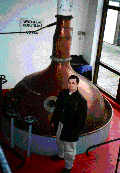
Dan at Van Eecke

Brewer Statue
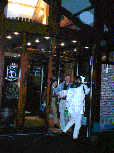
NEW Cafe de Vrede
|
| Friday
morning we ate a great buffet breakfast at the hotel, then we set off to
taste authentic Belgian Lambics, which can only be brewed in a small area
of Belgium. Our first stop was Cantillon (Gheudestraat 56 in Anderlecht,
a region of Brussels.) We were greeted and given a booklet as we
set out on a self-guided tour of Cantillon's lambic brewery. Only
very old hops are used in lambics, to act as a preservative for the beer
without giving a "hoppy" flavor. A cat is always kept in the
brewery to protect the stored hops, wheat, and malted barley from rodents.
After brewing, the beer is put in a copper cooling tank up in the attic
of the brewery. This copper tank is like a large tray, about 12 inches
deep. The attic walls and ceiling are full of ventilation to allow
the native yeasts to come into the beer to start the fermentation process.
This style of beer can only be brewed from October to March. A lambic
brewery is not a sterile environment. The walls and ceiling of the
attic are also covered with mold and mildew. The brewery is fostering
the cultures which have helped them produce excellent lambic for many years.
After cooling overnight, the lambic is aged and fermented in oak casks.
Some of the lambics are aged as long as three years in the casks.
Once bottled, the beers are stored in their bottles and aged some more.
Lambics are usually corked and capped when they are bottled. When
we completed the brewery tour, we proceeded to the tasting room.
Two year old lambic: excellent, dry, sherry-like, and still (no foam).
Four week old lambic: can't be bottled, still in the early stages of fermentation,
tart horse-blanket flavor. Kriek: young, O-o-o-o from Julie, great
natural sour cherry flavor and aroma, tart almond undertone from pit, oaky
taste from wood casks. Framboise: raspberry lambic, earthy, musty,
smooth, aftertaste of raspberry, fruit flavor is more delicate than that
of Kriek. Geuze: complex (yummy!), lively, carbonated, sparkling,
similar to champagne, but better, a blend of one-, two- and three-year-old
lambics. Vigneronne: grape lambic, wonderful aroma of fresh grapes,
a refreshing drink. Faro: a sweetened lambic, half liter of sugar
is added to each 10 liters of beer. The members of the family that
runs the Cantillon brewery are known as "brewing fundamentalists."
The brewer who served us our samples and answered our questions was Jean
Van Roy. His mother was the last of the Cantillons.
Next we made our way south to the town
of Beersel and toured the lambic brewery of Oud Beersel (Laarheidestraat
230). We especially enjoyed the old-fashioned tools used in the brewing
process. We had to leave to eat lunch and planned to come back to
Oud Beersel to taste some of their lambics, but we ran out of time that
afternoon.
Our lunch was at Drei Fonteinen (Hermann
Teirlinckplein 3 in Beersel), a brewery and restaurant in the Senne valley,
just south of Brussels. Some of the specialties of the restaurant
included: bread with white cheese, green onions and radishes (delicious
-- the cheese is similar to cream cheese but fresher and milder), mussels
with geuze, rabbit in geuze sauce, salmon with geuze cream sauce, gouda
cheese sauce on seafood casserole. After lunch, we went on a tour
of the brewery. Armand, one of the proprietors, spoke with us but
had to go to an appointment. The brewer's apprentice showed us around
their recently updated brewery. Drei Fonteinen brews lambics and
other styles of beer, although we tasted only the lambic style beers while
we were there, since that is really their specialty. Geuze '93: old,
still rich, well-balanced, tarter due to age. Geuze '95: less acid
on the back of the tongue, excellent. Kriekenlambik: fruit flavor
of the cherries in the background.
We returned to Brussels and walked
from the hotel to the Grand Place, where we saw the Brewer's Guild House
and other important buildings. The guild house has a small brewing
museum that was closed when we came by. About a block from the Grand
Place we saw the Mannekin-Pis, a popular tourist attraction which is a
fountain of a young boy urinating. There were numerous "tourist-trap"
shops nearby selling lots of tacky Mannekin-Pis souvenirs. (We just
couldn't resist the corkscrew!) Across the street from the fountain
was the Poechenellekelder -- a pub that is decorated with lots of puppets
and has a fairly good beer selection. The server poured the beer
with a flourish, but failed to leave the last bit of yeast in the bottle,
as is customary when drinking fine Belgian beers. Rodenbach: fruity,
quenching, somewhat sour, fine carbonation. Rochefort Trappist Bier
10: strong alcohol (11.3%), chocolatey, flowery bouquet. Gordon's
Scotch Ale: not Belgian, but wonderful nonetheless. |
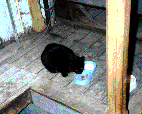
Cantillon Kitty

Owner of Oud Beersel
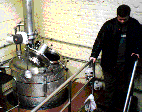
New kettle, Drei
Fonteinen
|
| From
the Poechenellekelder we had a good walk across Brussels to Le Bier Circus
(Rue de l'Enseignement 89). This was by far our favorite pub in Brussels,
due to the extensive beer menu. The menu listed 200-300 Belgian beers
by both style and brewery, giving a description of most of them.
The server poured the beers properly here, leaving the last bit of yeast
in the bottle for the patron to drink or not. Again we noted the
specific glasses to go with each brewery - sometimes a special glass for
a specific beer. Silly Scotch: actually Belgian, lighter than Gordon's.
Helleketelbier: by DeBie in Watou, witch stirring kettle on label, honey/cherry
aroma. Oud Beersel Kriek: great Kriek. Witkap Pater Trippel:
aftertaste sneaks up on you. Strawberry Lambic: by Hanssen's, excellent,
the fact that the fruity flavor of the strawberry came through is amazing,
came in an unlabeled bottle. Westvleteren 12: just as good as yesterday.
Leifmann's Frambozenbier: brown ale with raspberry, sweet, malty, raspberry
flavor. Saison DuPont: amber wheat beer, spicy, floral scent.
McChouffe: by D'Achouffe, good brown ale, butterscotch aroma. We
could have spent many hours tasting beers at Le Bier Circus, but we settled
for two beers per person and set off for dinner.
Dinner on Friday was at in t'Spinnekopke
(1 Place du Jardin aux Fleurs, Brussels.) Alan, our waiter, was very
attentive and friendly. Some of the food specialties included:
mussels with abbey beer, salmon with white beer, scallops with abbey beer
(rich with roe on them), nice cheese fritters with fried parsley and a
good veggie plate. The desserts were amazing! The most appropriate
and unique was the beer sorbet served with three sorbets - made from Kriek,
white beer, and Maredsous (LeFebrvere brewery). This sorbet was a
real treat. We didn't have anything like this anywhere else.
Other excellent desserts were the chocolate mousse and profitrolles.
Hommelbier: by Van Eecke, honey, hops, estery, fruity ale. Cantillon
Kriek: just as good as this morning. Tripel Karmeliet: by Bosteels,
excellent, rich mouth feel, sweet, flavorful, complex - the great surprise
of the evening as Owen had never tasted this beer before.
After dinner we went to one more pub,
Falstaff, in Brussels. Falstaff is a pub from the 1920's with lots
of stained glass and marble-topped tables. Kasteel Beer: by Biere
du Chateau, rich, sweet, overpoweringly malty, chocolatey, hint of Belgian
spiciness, a rich barley wine. Verboden Vrucht: by Hoeegarden, sour,
very fruity, aroma is sweet. |
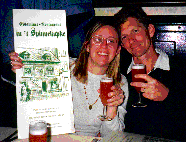
Ahhh... t'Spinnekopke
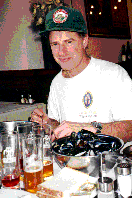
Mussels and frites
|
| Saturday
morning began again with a breakfast buffet at the hotel, then we took
a drive to Esen-Diksmuide to tour De Dolle Brouwers ("The Mad Brewers",
Roeselaerestraat 12b) This brewery is open only on weekends.
The two brewers each have other jobs. They are using most of the
profits from the brewery to help maintain and renovate the facility and
to preserve the "old-fashioned" methods of brewing. Their most popular
beer is Oerbier. The word "oer" means primitive, but our guide (the
mother of the brewers) explained that it is a homophone for the word that
means prostitute, so there are a lot of jokes made about this beer.
The brewery is painted and decorated with artwork done by one of the brewers,
who is also an architect and an artist. We arrived as the beer was
cooking, and a local farmer had come to take away the spent grains from
the mash tun to feed his livestock. Oerbier: the most popular beer
by De Dolle, brewed with six kinds of malt including black and caramel,
tastes of plum, cherries, velvety smooth, sweet grape aftertaste, iron
flavor. Arabier: dry-hopped, summer beer. Special Oerbier:
the brewer gave us a taste of this beer, brewed like the regular Oerbier
but aged in oak casks, tastes like a wine, this is not sold, but just made
for the brewers and their families.
From De Dolle we drove to Brugge.
We got stuck in a traffic jam on the way into Brugge and by the time we
got there and parked we were starving and ready for lunch. The restaurant
where we were planning to eat was full, so we found another place.
We ate a very, very late lunch and then separated into a few small groups
to do some shopping. Most of us were under strict orders not to return
home from Belgium without some chocolates and lace, others went in search
of Cuban cigars, and of course we found some great beers at the shops.
When our group reunited, we checked
out the Brugs Beertje (Kemelstraat 5 in Brugge.) This pub is decorated
with lots of beer signs, has a great atmosphere, and has an outstanding
selection of beers. The beer menu is almost as extensive as the Bier
Circus in Brussels. Brugs Tarwebier: by De Gouden Boom of Brugge,
white beer, citrusy, refreshing. Barbar: by Lefebvre of Quenast,
wild woman on label, blond honey beer, spicy, honeyish, floral perfume,
slight taste of orange/coriander/ginger. De Koninck Cuvee: estery
aftertaste, millennium beer, clear and pretty, like a pale ale with a bit
of pepper, spicy with pepper undertones, a straight-forward beer.
Brugse Tripel: De Gouden Boom, spicy citrus flavor, and good head retention.
Even though we had such a late lunch,
we were all still hungry, so we walked to La Civiere D'Or for dinner.
White asparagus, a local specialty, was in season. It was served
with Hollandaise sauce or in the Flemish style (with chopped eggs, garlic
butter, nutmeg and parsley.) The restaurant had photos of celebrities
and autographs from when they visited. Specialties included: mussels
in white beer with curry sauce, served with the usual frites; Flemish beef
stew; scallops au gratin; and raw oysters (these were very fresh, out of
a salt water tank in the restaurant, and they were still squirming!)
The desserts were wonderful - Grand Marnier souffle, chocolate mousse,
flan, etc. We all drank the Brugge Tarwebier, which was light and
refreshing with our dinner.
Saturday night, when we got back to
Brussels from Brugge, four of us went out to two more pubs. We felt
we just couldn't pass up the opportunity to taste a few more marvelous
Belgian beers. The first was A la Becasse, which means something
like "just because." This pub serves lambics from traditional stoneware
pitchers. The waiters wore white aprons laced up with string in back.
We had some Fromage Blanc (white cheese) with radishes and onions, similar
to what we ate at Drei Fonteinen. Timmerman's Kriek Lambic: on draft,
sweetened, not entirely authentic lambic, pleasant and drinkable, a little
easier on the stomach than traditional lambics. Then we walked a
few blocks to Lunette. This pub has some extra-large glasses in addition
to the normal size in case patrons want to get crazy. We suggest
sitting upstairs for a more pleasant atmosphere, especially if you can
sit by the picture window for a view of the plaza or "platz." Westmalle
Dubbel: dark colored, malty, fruity brown ale. Rochefort 8: trappist
ale, slightly lighter version of Rochefort. Westmalle Tripel: peppery,
spicy, hoppy, fruity, good head retention, white candy sugar, tasty, much
better to our taste than their double.
Sunday morning after breakfast we had
to load up the van. Our luggage had doubled in size and probably
weighed four times as much as it did on the way to Belgium. We all
had cases of beer carefully packed in our carry-on bags - some inside socks,
some still in boxes, any way we could pack them safely. The van was
scraping the wheels and bottoming out as we turned corners and drove on
the slopes in the parking garage to return it. With all the beers
we were carrying, there was only one beer casualty - Dan dropped and broke
an Oerbier at the check-in counter when he had to rearrange his luggage.
After checking our luggage we had some lunch and drank our last beers in
Belgium at the airport lounge. Those of us unfortunate enough to
have carry-on luggage without wheels got a workout as we carried our bags
to the departure gate (near the far end of the terminal, of course.)
Despite the relatively small amount
of area we covered, we tasted a remarkable variety of beers of incredible
quality. The amazing thing is that we have only scratched the surface
- there are many more fine Belgian beers -- we just didn't have time to
taste them all in three days. We did make a valiant effort, though,
and our fearless leader, Owen, ensured that our beer tasting opportunities
were maximized on this trip. A poster we saw at De Dolle sums it
up: "The size of Belgium is in inverse ratio to the greatness of its beers."
We can't wait to go again!!! |

De Dolle

Brewer's Mama
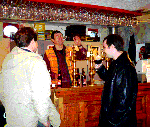
De Dolle Tasting
Room

Antique beer signs
at
Brugs Beertje
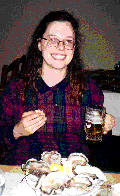
Julie's Wit Beer
and
VERY fresh oysters
at La Civiere D'Or
|
(Note from Owen: Many
thanks go to beer sampler Jeanie Hyatt for her marvelous note-taking and
photography on this trip. She did a wonderful job in writing this
travelogue.) |
